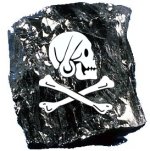While there is increasing use of renewable energy in powering Australia; coal still remains a major player and will continue to be for a long time; short of any drastic measures taken to eliminate its use. Australia currently generates around 80 percent of its power from coal and has one of the most coal-intensive economies on the planet.
Australia has a set a target of just 20 percent renewable energy generation by 2020; so even after that date, coal will still feature heavily in our energy mix.
The use of coal and its role in greenhouse gas emissions is well known, but an issue often overlooked is the subject of mercury. Mercury is a toxic, persistent pollutant that accumulates in the food chain.
Coal-fired power plants are the single largest source of mercury air pollution, accounting for roughly 40 percent of all mercury emissions. According to Greenpeace, there are no commercially available technologies to prevent mercury emissions from coal-fired power plants and “clean coal” methods only move pollutants from one waste stream to another.
Atmospheric mercury falls to Earth through rain, snow and dry deposition. Once in lakes, rivers and streams it can transform into methylmercury, one of the most toxic substances known to man, where it can accumulate in the tissues of aquatic organisms. In humans, ingested methylmercury is readily and completely absorbed by the gastrointestinal tract.
A study conducted by the U.S. Geological Survey (USGS) found every fish tested from 291 freshwater streams across the United States was contaminated with mercury. Over 66 percent of them had mercury levels higher than those set by the Environmental Protection Agency as a level of concern for fish-eating mammals and over 25 percent of the fish were contaminated at levels above those set as the threshold for human consumption.
While we can all do our bit in lowering power generation related mercury emissions using strategies ranging from simple energy efficiency to installing home solar power systems, some would say it’s not enough for Australia to simply stop using coal, but we also have to cease our exports. This is an extremely sensitive topic given Australia is the largest coal exporter in the world. Australia’s black coal exports were worth around $A22.5 billion in 2006-07 and black coal remains Australia’s largest commodity export.
However, Dr. James Hansen, climate scientist and head of NASA’s Goddard Institute of Space Studies, was recently in Australia giving a series of lectures and said if Australia continued to increase its export of coal, it is in effect “becoming a drug dealer for the world”.












































